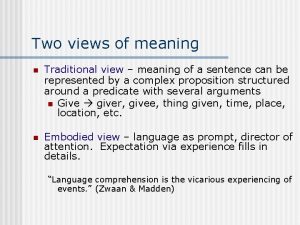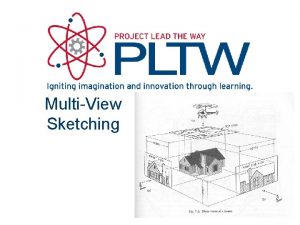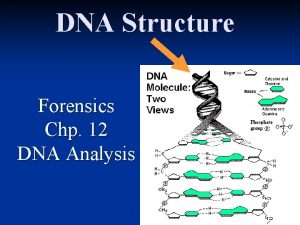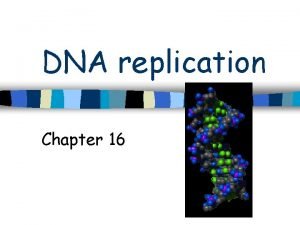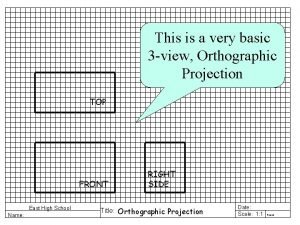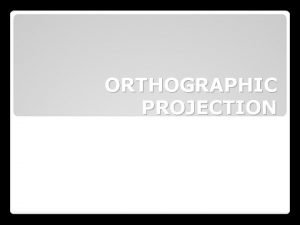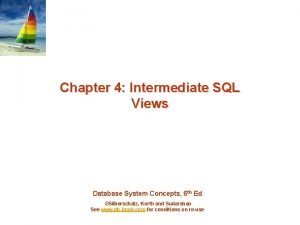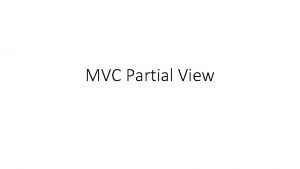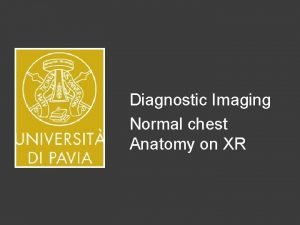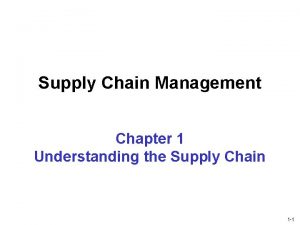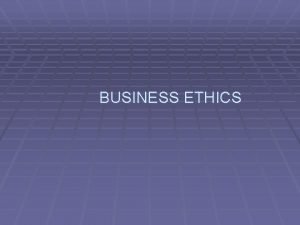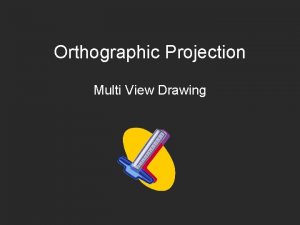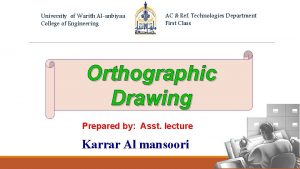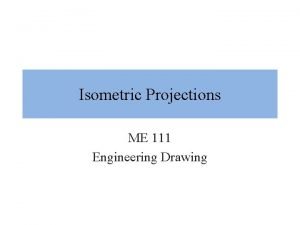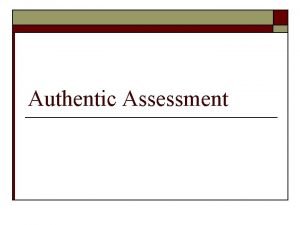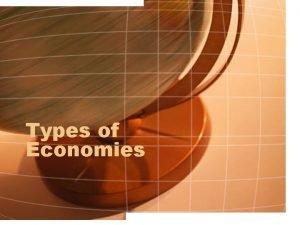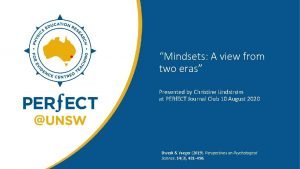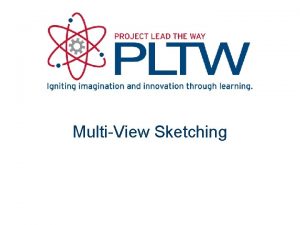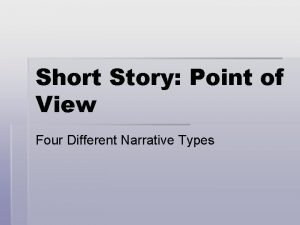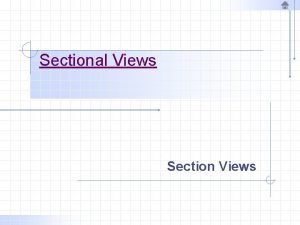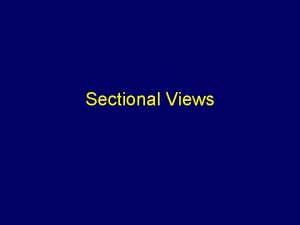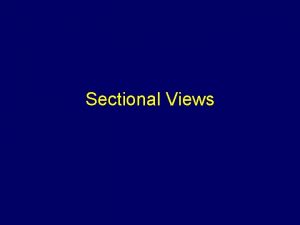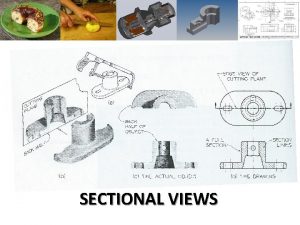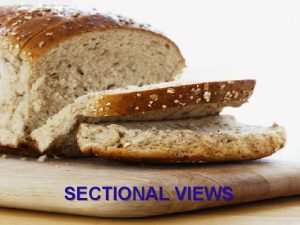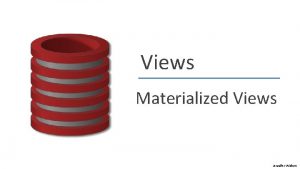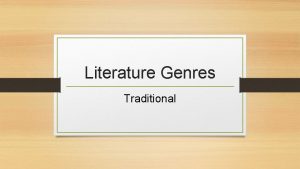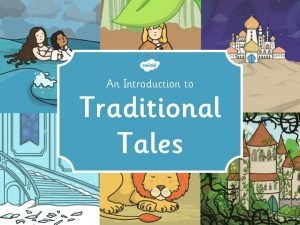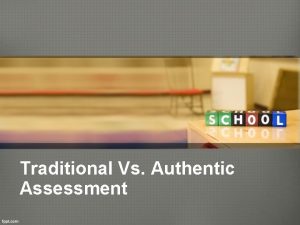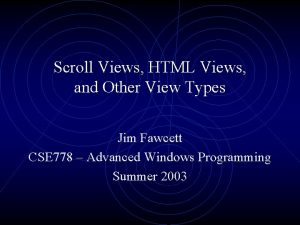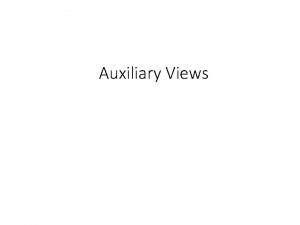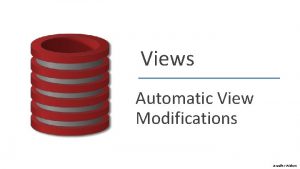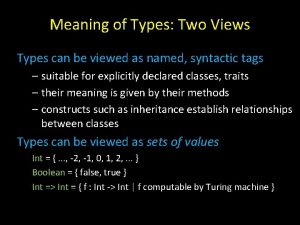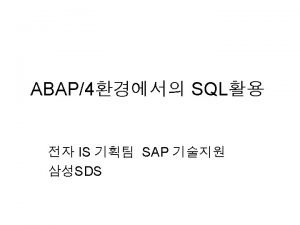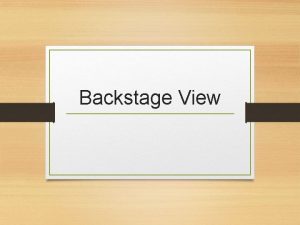Two views of meaning n Traditional view meaning
































- Slides: 32

Two views of meaning n Traditional view – meaning of a sentence can be represented by a complex proposition structured around a predicate with several arguments n Give giver, givee, thing given, time, place, location, etc. n Embodied view – language as prompt, director of attention. Expectation via experience fills in details. “Language comprehension is the vicarious experiencing of events. ” (Zwaan & Madden)

Embodied view of meaning “Very sparse grammar guides us along the same rich mental paths, by prompting us to perform complex cognitive operations. What is remarkable is that by and large subjects engage in quite similar constructions…. The reason seems to be that the cultural, contextual, and cognitive substrate on which the language forms operate is sufficiently uniform across interlocutors to allow for a reasonable degree of consistency in the unfolding of the prompted meaning constructions. ” (Fauconnier) < http: //cogweb. ucla. edu/Abstracts/Fauconnier_99. html

Symbol grounding problem n Symbol grounding problem “Although cognitive neurolinguists examine the neural basis for human linguistic abilities, most research on the links between language and brain functions ignore the importance of people’s ordinary, kinesthetic experiences” (Gibbs) n High dimensional representation “There may be ways in which embodied meanings can be explicitly part of propositional and high-dimensional representations of linguistic meaning. ” (Gibbs)

Indexical hypothesis (Glenberg < Gibbs) (1) (2) (3) Words and phrases indexed to objects in environment Affordances derived What are the ways of interacting with objects mentioned? Meshing of affordances to constrain meaning possibilities

Indexical hypothesis n Shorter reading times for afforded sentences than non-afforded 1. Art used the chair to defend himself against the snarling lion 2. Art used the chair to propel himself across the room

Beachcomber model n Beachcomber model (Zwaan & Madden) “The mind is like a beachcomber, taking whatever is washed up on the beach to build structures. Each piece of driftwood has a particular shape, which puts constraints on where the piece will fit in the evolving structure…and on whether and how subsequent pieces will fit” 1. 2. Fred stole all the books in the library. Fred read all the books in the library.

Evidence for embodied understanding n (Zwaan, Magliano & Graesser < Gibbs) Longer reading times for parts of stories exhibiting changes of character, location, time period, etc. n People appear to flesh out important embodied characters as they read

Evidence for embodied understanding Evidence that listeners assume perspective of Protagonist Experiment 1: (Morrow, Bower & Greenspan < Gibbs) Task: subjects memorize building layout including objects in rooms. Then, they read a story describing a person moving through building.

Where is the piano/book? Where is the bathtub/sofa? Fast response Slower response

Evidence for embodied understanding Experiment 2: (Keefe & Mc. Daniel < Gibbs) Task: read a sentence then pronounce a word. Ex. 1. 2. After standing through the three-hour debate, the tired speaker walked over to his chair. The tired speaker moved the chair that was in his way and walked to the podium to continue three-hour debate. Subjects were able to pronounce word sat faster after reading sentence (1) than (2).

Evidence for embodied understanding Experiment 3 (Glenberg, Meyer & Linden) Task: Read sentence, see word, decide if word was mentioned in sentence. Ex. 1. The jogger took off the sweatshirt before jogging. 2. The jogger put on a sweatshirt before jogging. Faster decision time for sweatshirt if sentence (2) read than sentence (1).

Cognitive linguistics n Cognitive linguistics “language is in the service of constructing and communicating meaning, and it is for the linguist and cognitive scientist a window into the mind” (Fauconnier)

Cognitive linguistics n “Language is only the tip of a spectacular cognitive iceberg, and when we engage in any language activity, be it mundane or artistically creative, we draw unconsciously on vast cognitive resources, call up innumerable models and frames, set up multiple connections, coordinate large arrays of information, and engage in creative mappings, transfers, and elaborations. ” (Fauconnier)

Cognitive linguistic evidence for embodiment n “Cognitive linguistic research analyzes systematic patterns of conventional and novel linguistic expressions to uncover patterns of metaphorical though that give rise to such language. ” (Gibbs) n Ex. ANGER IS HEATED FLUID IN A CONTAINER

Cognitive linguistic evidence for embodiment Ex. (Gibbs) Being angry is such a complicated emotion. At first, anger burns in my chest… the anger just boiled inside me…Simply telling him that I was upset made my anger fizzle out a little. As we talked my anger slowly melted away.

Cognitive linguistic evidence for embodiment n Image schema n Fundamental experiential categories Verticality, color, cause/effect, source-pathgoal, containment n Do image schemas aid in interpreting metaphorical expressions? n Ex. Does our bodily understanding of containment aid in interpreting idiomatic meaning of expressions relying on a containment metaphor such as He blew his stack.

Cognitive linguistic evidence for embodiment Gibbs Study 1 n Physical reality - container exploding is caused by internal pressure caused by increase in heat, explosions is unintentional and violent n Will people understand anger idioms (with containment basis) differently than literal paraphrases? 1. Blow your stack/flip your lid 2. Get very angry

Cognitive linguistic evidence for embodiment n Easier to process blow your stack when in context that described cause of anger as due to internal pressure, where expression was unintentional and violent. Longer to read if these contradicted (compared to got very angry? ) 1. 2. *Slowly/quietly/carefully, he blew his stack. Slowly/quietly/carefully, he got very angry.

Cognitive linguistic evidence for embodiment Gibbs study 2 Task: Read a sentence, see a word. Lexical decision task based after seeing word. Ex. Read sentence like: 1. John blew his stack 2. John got very angry 3. John bit her head off See word like: heat or lead

Cognitive linguistic evidence for embodiment n Lexical decisions made faster if word viewed after reading a sentence containing metaphorical language cohered with that metaphor.

Cognitive linguistic evidence for embodiment Gibbs Study 3 Examine Desire as hunger metaphor Hunger experience n Stomach grumbles n Stomach aches n Feel dizzy n *Knees swell 1. 2. I have a stomach pain for my old way of life *My knees swell for information about my ancestry

Cognitive linguistic evidence for embodiment Gibbs Study 4 Examine metaphorical extensions of stand 1. Relevant Image schemas identified for literal meaning of stand n Balance n Verticality n Center-periphery n Resistance n Linkage

Cognitive linguistic evidence for embodiment 2. Image schemas ranked for metaphorical uses It stands to reason As the matter stands Linkage > balance > center-periphery > resistance > verticality Don’t stand for such treatment Stand against great odds Resistance > center-periphery > linkage > balance > verticality

Cognitive linguistic evidence for embodiment 3. Assess whether senses of stand seen as being similar were predictable from image schema profiles n n 79% of results were predictable Image schematic meaning (body based) significant part of foundation for linguistic meaning

The embodied mind n n Fallacy of mind/body separation--no separate faculty of reason. The mind is the body. Structure of world is body-based Categorization is what we do as neural beings Categorization creates structure, allows us to comprehend the world and make decisions that advance our goals.

The embodied mind n Humans, like animals, are neural beings with similar fundamental needs: food/water/shelter/sex n Simple animals have abilities to recognize food from non-food. n More advanced animals have more capacity to create categories

Color as embodied percept n Color is not in the world, but in the brain Experience of color depends on: 1) Wavelength of reflected light 2) Lighting conditions 3) Receptors 4) Neural circuitry n Thinking of color as the internal representation of the external reality of surface reflectance is inaccurate

Color as embodied percept n Bananas are yellow n n Lighting conditions drastically alter the actual wavelengths hitting our retinas, yet no color change is perceived The sky is blue n The sky is colorless

Basic level categories n It appears that our concepts reflect the world as it is---rather, we identify the objects around us based on how we interact with them. n Basic level categories n Based on our optimal interaction with the environment

Basic level categories Berlin and Rosch – Basic level categories 1. Highest level at which a single mental image can represent the entire category n Chair, screwdriver, dog (basic) n Furniture, tool, animal (superordinate)

Basic level categories 2. Highest level at which category members have similarly perceived overall shapes. cat, but not animal, hammer, but not tool 3. Highest level at which a person uses similar motor actions for interacting with category members Separate motor programs for interacting with chair, bed, table, but not for interacting with furniture.

Basic level categories 4. Level at which most of our knowledge is organized
 Traditional views meaning
Traditional views meaning Drawing missing orthographic views
Drawing missing orthographic views There are how many positions of isometric axes
There are how many positions of isometric axes Multi-view drawings
Multi-view drawings Hypergamous marriage
Hypergamous marriage Dna molecule two views
Dna molecule two views Phosphodiester bond
Phosphodiester bond The orthographic view drawn directly above the front view
The orthographic view drawn directly above the front view Dimensioning section views
Dimensioning section views This view represents
This view represents Full section and half section
Full section and half section Worms eye view camera shot
Worms eye view camera shot Top view orthographic projection
Top view orthographic projection For the view create view instructor_info as
For the view create view instructor_info as Simple view and complex view
Simple view and complex view Simple view and complex view
Simple view and complex view Simple view and complex view
Simple view and complex view Partial view in mvc
Partial view in mvc X ray indication
X ray indication Cycle view and push/pull view of supply chain
Cycle view and push/pull view of supply chain Operating system definition
Operating system definition Unitarian view of ethics
Unitarian view of ethics Multi-view projection
Multi-view projection Front view top view
Front view top view Cylinder isometric view
Cylinder isometric view For the view create view instructor_info as
For the view create view instructor_info as Definition of authentic assessment
Definition of authentic assessment Traditional policing
Traditional policing Traditional economy advantages
Traditional economy advantages False growth mindset
False growth mindset Multiview drawing
Multiview drawing What are the two orthogonal view of software
What are the two orthogonal view of software Point of views in a story
Point of views in a story
